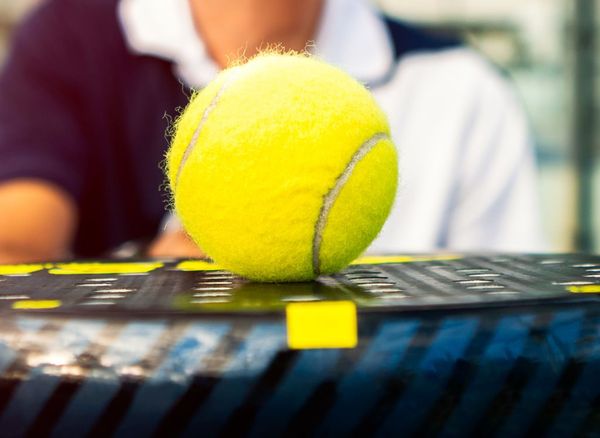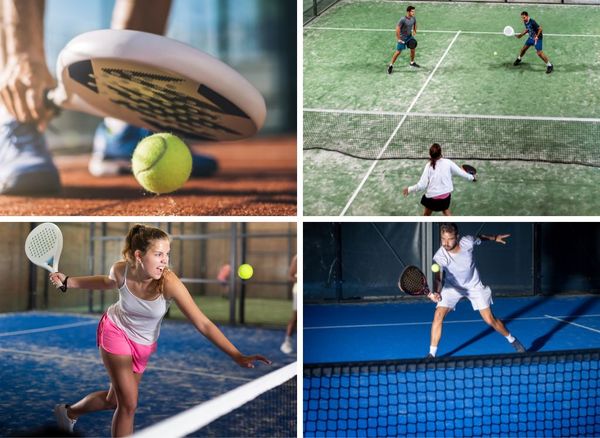Padel is a popular Latin American game that has gained traction all over the world, particularly in the United States.
It is a racquet sport with similarities to tennis, played on an indoor court roughly one-third the size of a tennis court.
It is especially appealing due to its faster pace and exciting rallies composed of volleys and angled shots that involve bouncing the ball off walls.
In this article we will be discussing:
Differences between Pickleball and Padel
Differences between Paddle Tennis and Padel
Rules and Setup of a Match
Some Strategies & Techniques of Play
Differences between Pickleball and Padel:
- Though both Pickleball and Padel are racket sports played on courts divided by netting,
- they have distinct differences in terms of equipment (Pickleball uses wooden paddles while Padel rackets typically utilizes wood, graphite composite or aluminum frames)
- as well as court size (Pickleball being three times larger than Padel). Standard Pickleball courts measure 20 feet wide by 44 feet long whereas standard Padel courts measure 32 feet wide by 60 feet long - making them larger than any average Pickleball court.
- Padel play uses the walls - The walls form the perimeter of the court, generally measuring 6 to 10 feet in height. The main purpose of these walls is to keep the ball from flying out during play, but they can also be used for hitting back shots. Many courts are equipped with glass walls so that players can subtly hit back shots from any angle and still keep the game going.
- Padel has more complicated rules compared to Pickleball such as it's a traditional scoring system that assigns points when either team fails to return the ball. Pickleball usually follows an 11-point system: each team plays until one side earns 11 points (or wins by 2 points), while Padel has adapted the 15 point score system from traditional tennis where you must win by two clear points
Differences between Paddle Tennis and Padel:
- The main difference between these two games lies in their
- court sizes - a standard paddle tennis court being twice as long as padel - making it easier for players to get away from the net during play.
- Padel play uses the walls - The walls form the perimeter of the court, generally measuring 6 to 10 feet in height. The main purpose of these walls is to keep the ball from flying out during play, but they can also be used for hitting back shots. Many courts are equipped with glass walls so that players can subtly hit backshots from any angle and still keep the game going.
- Additionally, paddle tennis utilizes smaller rackets that facilitate better control while padel racquets are more durable due to their bigger sizes.
- Lastly, there are also unique rules applied to each game such as how point scoring works differently in paddle tennis with points awarded when either team fails to hit the ball twice consecutively.
Rules and Setup of a Match
Basic rules of play and Court size/shape information:
- In general, padel follows similar guidelines as those found in traditional tennis with some minor variations such as allowing an extra 'bounce' (off any surface) before returning your opponent’s shot back into their court; or having nets suspended around all four sides instead of just at the front like in normal tennis matches.
Court:
- As for court size/shape information, a standard padel setup consists of a rectangular playing area measuring 10m x 20m with nets extending up 2m from each side wall up until 3m from both ends where they taper off into triangles forming sort of an 'O' shape at ground level which provides access within each half of the court but still allows balls struck outside this area to be considered ‘out’ or ‘faulted’ by either player during gameplay.
Equipment:
- The most common type of equipment used for playing Padel is a racket and a ball. Padel rackets typically come in four sizes - junior, adult, professional, and tournament sizes - and can be made of different materials such as fiberglass, wood, or steel. They feature a slightly larger head size than ordinary tennis rackets.
- When it comes to balls, they must be made of rubber material and should weigh between 40 – 45 grams each. Balls can come in two varieties - regular wire-core balls that offer more control but less power, or extra-dense hollow core balls that provide more power but less control. It is important to note that the players must agree on which kind of ball to use before the match starts.
- In some cases, protective eyewear may also be required when playing Padel as the balls can travel at high speeds from both close and long-range shots. Other optional pieces of equipment for advanced players include wristbands for increased grip and sweatbands for improved comfort during long rallies.
Point structure/scoring system:
- The point structure/scoring system employed by padel is based heavily upon traditional tennis rules - 15–30–40 then game if advantage held upon 40 – but also includes slight adjustments related to when teams fail four consecutive times whilst attempting returns (15–30–50 then deuce) along with how serves should be split evenly every four points regardless if someone holds tour opponents scoreless or not (the only exception being after deuce where servers alternate every other point).
Strategies & Techniques
Types of serves (reverse serve, kicker serve, accelerator serve, suicide serve):
- There are several types of serves used in padel with each possessing its own benefits and drawbacks.
- The reverse serve provides the server with more power by using a full swing and can be used when playing against two back players who have been pushed close to the wall.
- The kicker serve is a great way to disguise a player’s intended direction of play as it moves quickly off the net making it difficult for opponents to predict where the next shot will come from.
- The accelerator serve is best suited for short-court play and allows the server to add plenty of spin when hitting the ball giving them greater control during gameplay while still keeping rallies competitive.
- Lastly, there’s the suicide serve - which despite its name - is one of the safest and most accurate baseline serves because it requires only minimal backswing and leaves very little time for opponents to react.
Offensive strokes (forehand, backhand, overhead), defensive strokes (slice backhand, half volley):
- Offensive strokes are extremely important in padel due to how much faster-paced/intense rallies tend to be compared to normal tennis matches with each successful exchange being determined by either team’s ability to leverage their appearance angles and execute precise shots that keep their opponents guessing.
- In terms of forehands players should try to establish good form before striking the ball by keeping the head down facing towards the target alongside an adequately sized backswing whilst maintaining correct grip size/position throughout motion;
- similarly when utilizing overheads take adequate time setting up the hit as well as position yourself correctly so that you have better chances of seeing the results desired after contact is made with the racquet face surface
- As far as defensive strokes go slice backhands perfect option if you need slowing rally down a bit allowing yourself to regroup and prepare your next move whilst half volleys excellent choice for anyone looking to counterattack quickly since they require the lowest level of effort/energy out all other offensive options use during the match (short compact arm movement allowed)
Playing against walls for strategic advantage:
- Padel is unique compared to other racket sports in this sense that wall surfaces can be used to strategic advantage depending upon the situation available – i.e., taking away space from opponents and preventing them from returning shots thus gaining yourself an extra point or playing angled shots bounce off walls providing natural ‘bumpers’ when attempting to make more difficult returns resulting less chance error during rally due low risk given to set up.
Tactful use of spin and placement for maximum effectiveness during a match:
- While having sound technique important in any type of racquet sport mastering tactful use of spin along placement can give players the utmost confidence needed to achieve success during matches since both these aspects allow carry out feasible strategies easily regardless of the oppositions present on the court.
- Players should look into incorporating different spin varieties such as top spin underspin side spins etc aiming to confuse opponents and put pressure upon them whilst positioning shots optimal spots pinpoint accuracy to glean maximum effect from every exchange (particularly near-end sections near net sidewalls).
Overall, whether you're looking for an intensely competitive game or simply want to enjoy some leisure activity with friends - it's important to understand what makes each game unique to get maximum enjoyment out of it.
Both pickleball and padel offer plenty of fun regardless of your skill level so choose whichever suits your needs!







